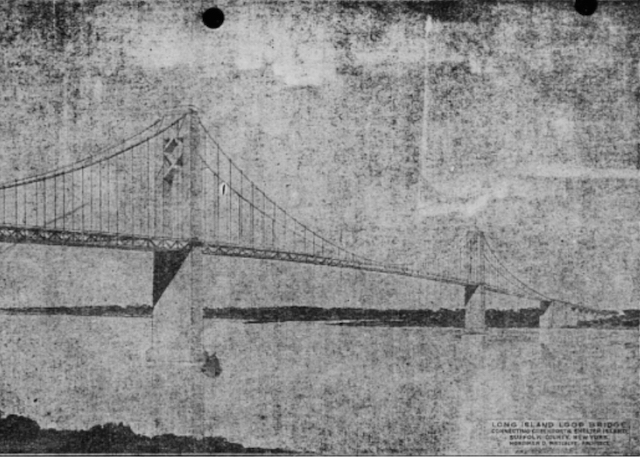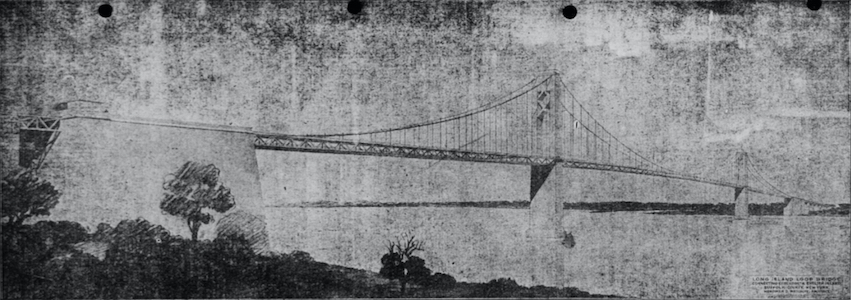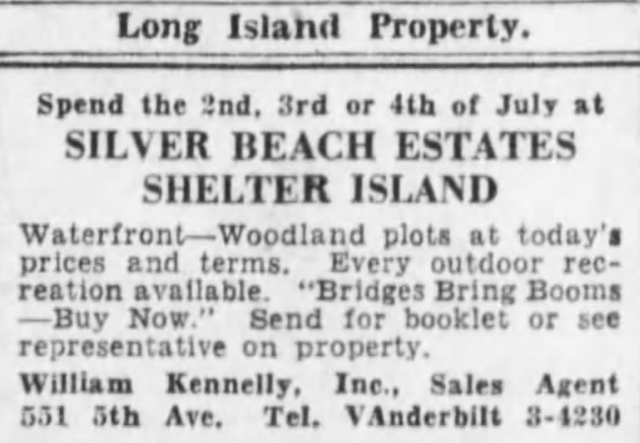
Charity Robey’s excellent article in The New York Times drawing attention to the financial straits of our ferry operators has raised questions about Shelter Island bridges that were long ago rejected.
Here’s what we found about the so-called “Loop Bridges” in old newspaper archives.
As early as the 1890s — following winters so cold that the Island was ice-bound without connection for weeks at a time — people were calling for a bridge to connect Shelter Island to Greenport.
According to coverage in the Times-Union newspaper of Brooklyn, plans were also put forth in 1913 and 1925. None gained much traction, even though in 1913 Francis “Borax” Smith of Shelter Island, promised to personally pay for a span to connect Shelter Island to North Haven if the state built one to Greenport.
In 1931, a plan to build two spans became the focus of serious attention on the East End for nearly a decade (and was revisited in the 1960s). They would have connected the two forks of eastern Long Island using Shelter Island as “their center span,” according to one newspaper account.
Tolls would’ve been collected, 50 cents from Greenport and 40 cents from Sag Harbor, it was said. The goal was to pay off the cost of the bridges within 15 years.
Among those who decried the plan were prominent yacht owners who complained that the bridges would impede the passage of their boats. Oystermen, too, came out against the plan, concerned for the health of the seabed.
But promoters, taking up the slogan “Bridges Bring Booms”, were convinced that Suffolk County would falter economically without bridges to connect the two East End forks. The mayors of Sag Harbor and Greenport both spoke out in support.
The naysayers were ultimately successful in preventing the construction; despite promised federal funding from the Public Works Administration, the Suffolk County Board of Supervisors failed to act and the idea fizzled.

The northern bridge depicted in the illustration above (published by The Watchman of the Sunrise Trail in 1937), would’ve connected Cleave’s Point in East Marion to Hay Beach. It was planned at 4,700 feet long, with a center span of 1,070 feet and a clearance above the water of 131 feet, the same as the Brooklyn Bridge.
The southern bridge would’ve connected North Haven to the area of the South Ferry landing. It was planned at 2,240 feet long with a center span of 700 feet and clearance above the water of 70 feet.
‘Save time, temper and money’
In an editorial supporting the proposed spans, The Watchman of the Sunrise Trail wrote: “These bridges can be built without a cent of cost to the taxpayers. They can be financed by the sale of bonds to private individuals who would be reimbursed out of toll charges considerably lower than present ferry rates.”
“Travel will be speeded up for both business and pleasure motor vehicles,” the editorial said. “Tourists will save time, temper and money, and be given the opportunity to see both sides of beautiful Long Island the same day.”
The Watchman editorial said 68 vehicles were waiting in line on May 30, 1937. “How do you think those waiting autoists feel toward us? If you would like to know first hand, just parade up and down some of these waiting lines sometime and hear from from-out-of-county-visitors think about it all. Hear, with your own ears, how many of them swear they will never come to such a backward place again as long as they live.”
“As a matter of good business, we owe it to ourselves, if we expect to reap a maximum summer harvest from summer visitors,” the editorial said. “To us of Suffolk County, the Long Island Loop Bridges are an economic necessity 12 months in the year if we want to keep up with the march of progress and hold our own in the competition for business.”

A ‘still enchanted isle’
In March 1938, the New York Herald Tribune published an editorial (carried locally at the time by the East Hampton Star), describing the matter as about more than price. The state Assembly had passed and the state Senate was soon to act upon legislation enabling construction to go forward, the editorial said.
Should federal funding be secured, the plan would “import the lucrative blessing of real estate development, hot dog stands and road-house prosperity into that still enchanted isle.”
“The bridges will create values — but they will destroy them at the same time, though what is lost will be less easily measurable on the assessment rolls,” the editorial said. “No one, of course, would wait for a ferry if he could tear across a bridge; yet within a hundred miles of New York one can find few more rewarding ways of spending a half hour than hanging over the rail of the Shelter Island Sound ferry dock while the slightly asthmatic ferry boat collects a load on the other side.”
“On a hot summer’s noon there are peace and isolation there quite beyond price; the minnows wiggle about the piling, a tern may dive, and the tide ripples along the blue levels of the Sound between the wild strips of beach and the wooded shore. But with a bridge, it would be the same and no one would stop to look at it.”
Rejected, but not forgotten
In 1938, the federal government went ahead and sanctioned a $15 M plan by Robert Moses to improve access to Long Island beaches that included a bridge to Smith Point, with no funds for the Shelter Island bridges.
W. Kingsland Macy, leader of Suffolk County Republicans, vowed to put the matter before the federal government as soon as the beach improvement projects were completed.
But it did not come up again until 1966, when County Supervisor H. Lee Dennison revived the issue. Dennison, the county’s first supervisor, was an engineer by trade and was a proponent of plans to build an East End bridge across the Long Island Sound to Connecticut. Why go to all the trouble spanning the sound, without also completing the Suffolk County loop?
Francis X. Clines, a Shelter Island summer resident and then reporter for the New York Times (where he later joined the editorial board), wrote that Dennison’s plan would make the Island “a stepping stone between the north and south forks.”
“On this sleepy resort island people leave their keys in the cars without fear, phone operators listen in to conversation to see if they can assist in tracking down absent parties and progress is more feared than desired,” Clines wrote in an article published February 21, 1966.
“To protect this way of life, Supervisor Griffing recently persuaded the county board to erase a proposed road across his island, a necessary link in the bridge proposal,” Clines wrote. “But he knows governmental planners will continue the pressure for the bridges.”
Regarding the bridges, Suffolk County journalist Karl Grossman quoted Griffing putting it more bluntly: “If Dennison wants to rape Suffolk County, we want him to leave Shelter Island alone.”




